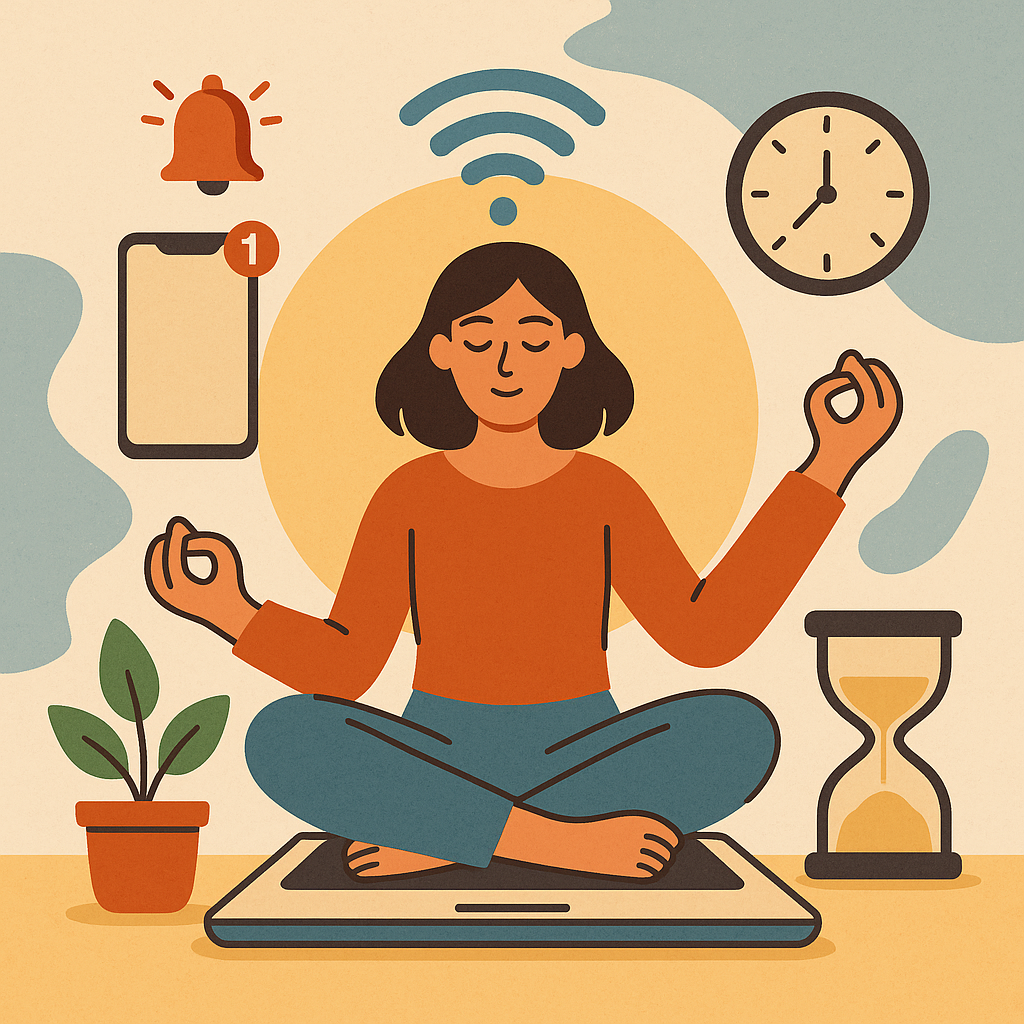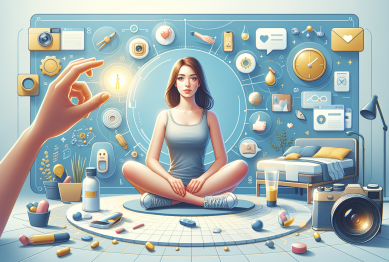In an age where digital technology permeates every aspect of our lives, it’s easy to find ourselves mindlessly scrolling, constantly multitasking, and overwhelmed by notifications. This constant connectivity, while valuable, often detracts from our well-being, focus, and productivity. Enter mindful technology—a practice that encourages us to engage with our devices consciously, with purpose, and in ways that enhance our lives rather than detract from them.
In this article, we’ll explore how to incorporate mindfulness into your technology use. From setting clear boundaries to using digital tools that promote mental clarity and productivity, this guide will help you reclaim control over your devices and bring more intentionality to your tech habits.

What Is Mindful Technology?
Mindful technology refers to the practice of using digital devices and tools in a way that promotes intentionality, well-being, and productivity. Unlike mindless scrolling, which can drain your energy and attention, mindful technology encourages you to engage with devices in ways that align with your goals and values.
At its core, mindful technology is about using tech in ways that support your mental health, foster positive habits, and help you achieve personal and professional objectives. Whether you’re checking emails, using social media, or working on a project, mindful technology helps you stay focused on the task at hand, avoiding distractions and burnout.
Key Elements of Mindful Technology:
- Intention: Using devices with a clear sense of purpose rather than as a passive escape.
- Boundaries: Setting limits on screen time and managing tech-related distractions.
- Conscious Consumption: Being mindful of the content you engage with, prioritizing what adds value to your life.
The Impact of Technology on Mental Well-Being
Before delving into strategies for using technology mindfully, it’s important to understand how technology impacts mental well-being.
In a world where people are constantly online, research shows that excessive screen time and engagement with social media can contribute to issues like anxiety, depression, and sleep disturbances. According to a study by the American Psychological Association (APA), technology use has been linked to higher levels of stress and reduced attention span (American Psychological Association, 2020). Furthermore, constant notifications and multitasking can cause cognitive overload, which makes it harder to focus and be productive.
On the flip side, when used mindfully, technology can have a positive impact. It can help you stay organized, manage your time effectively, and connect with others in meaningful ways. By becoming intentional about how we use technology, we can mitigate its negative effects and leverage its benefits for personal growth and well-being.
Practical Tips for Using Technology with Purpose
Here are actionable steps to incorporate mindfulness into your technology use:
1. Set Clear Boundaries for Screen Time
The first step in using technology mindfully is to establish clear boundaries around screen time. It’s easy to get caught in the cycle of checking your phone every few minutes, but this can lead to distractions and reduce your overall focus. By setting specific times to check emails, social media, and other apps, you can create a routine that prioritizes what matters most.
- Limit Screen Time: Use built-in features on your devices like Apple’s Screen Time or Android’s Digital Wellbeing to set daily limits on apps that tend to distract you.
- Set “Tech-Free” Zones: Designate certain areas, such as your bedroom or dining table, as tech-free zones to encourage healthier habits around technology use.
- Turn Off Notifications: Disable non-essential notifications to prevent constant interruptions. You can schedule “Do Not Disturb” hours to protect your focused work time.
2. Use Technology to Boost Productivity
Mindful technology doesn’t just mean reducing screen time; it also means leveraging digital tools that enhance your productivity and mental clarity. Use apps and software that help you stay organized, manage tasks, and achieve goals with purpose.
- Task Management Tools: Apps like Todoist, Notion, or Trello can help you track projects and prioritize tasks, ensuring you stay on top of your to-do list without feeling overwhelmed.
- Time Management Apps: Techniques like the Pomodoro method (working in 25-minute bursts) can help you focus. Apps like Focus Booster or Be Focused help implement these techniques.
- Digital Journaling: Use apps like Day One or Evernote to create a digital journal where you can reflect on your goals, track your progress, and document your experiences.
3. Engage in Purposeful Content Consumption
With so much content available online, it’s crucial to be intentional about what you consume. Mindful technology involves curating your digital environment to ensure you’re engaging with content that supports your values and enhances your knowledge.
- Follow Inspiring Accounts: On social media, follow accounts that inspire you or align with your goals. Avoid accounts that cause negative feelings or distractions.
- Use Content-Blocking Tools: Apps like Freedom or StayFocusd block distracting websites, so you can stay on track with your tasks.
- Limit Social Media Use: Instead of mindlessly scrolling through Facebook or Instagram, set specific times during the day to check social media. Consider using a timer to ensure you don’t exceed your allocated time.
4. Incorporate Mindfulness Practices into Digital Routines
Mindfulness practices like meditation, deep breathing, and mindful reflection can help counterbalance the stress caused by overusing technology. Integrating these practices into your digital routine can improve mental clarity and overall well-being.
- Guided Meditation Apps: Apps like Headspace or Calm offer guided meditations and mindfulness exercises that can help you center yourself before or after your screen time.
- Mindful Breaks: Take regular breaks from your devices to stretch, walk, or meditate. Apps like Insight Timer offer short mindfulness sessions that fit easily into your schedule.
- Limit Tech Usage Before Bed: The blue light emitted by screens can interfere with sleep. Set a “tech curfew” an hour or more before bed to relax and wind down without screens.
5. Practice Digital Detoxes
A digital detox is an intentional break from technology. By stepping away from screens for a period, you give your mind the space to rest and reset. Regular digital detoxes can help you regain focus, reduce stress, and reconnect with real-world activities.
- Schedule Tech-Free Days: Once a week, try to go without your phone, email, or social media for a day. Use this time to engage in hobbies or outdoor activities.
- Weekend Detox: Choose a weekend each month to unplug from all devices. This allows you to spend quality time with family, friends, or in solitude without digital distractions.
The Future of Mindful Technology
As we move forward, the integration of mindfulness into technology will only become more important. With increased awareness of the negative effects of overusing technology, more people are seeking ways to strike a healthy balance. The rise of digital wellness apps, screen time tracking features, and focus-enhancing tools are helping users adopt more mindful habits.
Future trends may also include the development of more personalized, AI-driven tools that help individuals understand their digital habits and guide them toward healthier tech usage. By using mindful technology, we can continue to reap the benefits of our devices while maintaining a sense of purpose and mental well-being.
Conclusion
Mindful technology is more than just a trend; it’s a movement that helps us take control of our digital lives. By incorporating mindfulness practices into our technology habits, we can foster better focus, reduce stress, and live with more intentionality. Whether you’re managing your productivity, improving your mental health, or simply looking to engage more consciously with your devices, the key is to use technology with purpose.
By setting boundaries, curating your content, using productivity tools, and practicing digital detoxes, you can transform your tech habits and create a more mindful relationship with the devices that shape your daily life.
References:
- American Psychological Association. (2020). Technology and mental health. American Psychological Association. Available at: https://www.apa.org
- Dube, R., & Lambiase, M. (2019). Digital mindfulness: How to balance tech use and mental health. Psychology Today. Available at: https://www.psychologytoday.com
- Wang, T. (2021). Digital well-being: How to practice mindful technology use. The Guardian. Available at: https://www.theguardian.com









